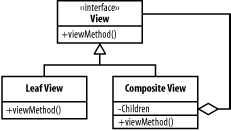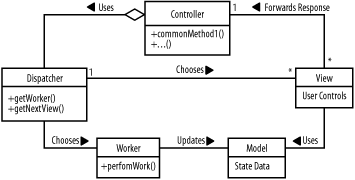| [ Team LiB ] |
|
A.2 Advanced Architectural Patterns
GoalBuilding a view from multiple reusable subviews (Figure A-7). Figure A-7. Classes in the Composite View pattern Participants
InteractionsThe dispatcher initializes a set of leaf views based on request or navigation data. The dispatcher then forwards control to a composite view, which includes multiple elements with generic names, such as leaf1. The correct leaf view, for example view1.html, is substituted for each generic name. The composite passes control to each leaf view in turn, each of which generates a portion of the final view. NotesSimple composite views can be implemented in a number of ways, including JSP include directives. A more flexible approach is to use templates that refer to leaves by generic names, allowing reuse of the template with different sets of leaves. JSP custom tags are usually the best way to implement templates. Templates are also included in the the Apache Struts "tile" mechanism.
Also Known AsDispatcher View GoalDecouple navigation from the front controller (Figure A-9). Figure A-9. Classes in the Service to Worker pattern Participants
InteractionsThe front controller intercepts all requests and performs common functions using decorators. The front controller passes request information to the dispatcher, which uses the request and an internal model to chooses and execute appropriate actions. The actions process user input, translating it into appropriate updates to the model. The model applies business rules and stores the data persistently. Based on the user input and results of the actions, the dispatcher chooses a view. The view transforms the updated model data into a form suitable for the user. NotesActions are typically implementations of the GoF Command pattern. The amount of functionality in the dispatcher, especially whether there is an internal navigation model, varies from application to application. The Service to Worker pattern is the basis of many presentation tier frameworks, including Apache Struts and Java Server Faces.
GoalAvoid over-specialization in views. Participants
InteractionsThe view uses a set of view helpers to translate from model data into an intermediate data model. Either the view or the view helper can translate the intermediate data into a form suitable for presentation to the user, such as HTML, WAP, or XML. NotesIn J2EE, view helpers are generally implemented as JSP custom tags. The tag may directly generate HTML, or it may expose scripting variables or JavaBeans that can be formatted into HTML by the JSP page. |
| [ Team LiB ] |
|